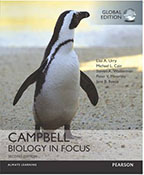Last edition Elsevier Campbell Biology in Focus is the best-selling “short” textbook for the introductory college biology course for science majors. Every unit takes an approach to streamlining the material that best fits the needs of instructors, based on surveys, curriculum initiatives, reviews, discussions with hundreds of biology professors, careful analyses of course syllabi, and the Vision and Change in Undergraduate Biology Education report. The Second Edition builds on the Campbell hallmark standards of accuracy, clarity, and pedagogical innovation, going beyond this foundation to help students make connections visually across chapters, interpret real data from research, and synthesize their knowledge. The accompanying digital resources include new, mobile-friendly tools that help instructors teach challenging topics better than ever before; integrate the eText with videos and animations; and allow students to test, learn, and retest until they achieve mastery of the content..
Last Edition
ISBN 13: 9781292109688
Imprint: Pearson Education
Language: English
Authors: Steven A. Wasserman
Pub Date: 05/10/2016
Pages: 1103
Illus: illustrated
Weight: 2,250.000 grams
Size: 231 X 258 mm
Product Type: Softcover
| List Price |
| grn2050 |
| $ 69,49 |
| to order |
- • The carefully chosen and thoughtfully crafted content of Campbell Biology in Focus emphasizes the core content of biology. For example:
- • Chapters 2 and 3 quickly review chemistry so that students reach the cell chapters sooner. If students need more chemistry review, MasteringBiology® offers 84 assignable chemistry tutorials and activities that are automatically graded.
- • Units 1-3 give students the solid foundation in cell biology, genetics, and evolution that they need in order to understand modern biology.
- • Unit 4 tells the story of the history of life by focusing on key events in the evolution of diversity, giving students an overview of life on Earth through time in four chapters.
- • Units 5 and 6 provide carefully selected examples and a more focused perspective on the interrelationship of form and function across diverse species of plants and animals.
- • Unit 7 applies the key themes of the text, including evolution, interactions, and energy and matter, to help students understand the fundamental principles and processes of ecology.
- Steven Wasserman. He is a professor at the University of California, San Diego (UCSD). He earned his A.B. in Biology from Harvard University and his Ph.D. in Biological Sciences from MIT. Through his research on regulatory pathway mechanisms in the fruit fly Drosophila, Steve has contributed to the fields of developmental biology, reproduction, and immunity. As a faculty member at the University of Texas Southwestern Medical Center and UCSD, he has taught genetics, development, and physiology to undergraduate, graduate, and medical students. He has also served as the research mentor for more than a dozen doctoral students and more than 50 aspiring scientists at the undergraduate and high school levels. Steve has been the recipient of distinguished scholar awards from both the Markey Charitable Trust and the David and Lucille Packard Foundation. In 2007, he received UCSD's Distinguished Teaching Award for undergraduate teaching.
- 1. Introduction: Evolution and the Foundations of Biology
- UNIT 1: CHEMISTRY AND CELLS
- 2. The Chemical Context of Life 3. Carbon and the Molecular Diversity of Life 4. A Tour of the Cell 5. Membrane Transport and Cell Signaling 6. An Introduction to Metabolism 7. Cellular Respiration and Fermentation 8. Photosynthesis 9. The Cell Cycle
- UNIT 2: GENETICS
- 10. Meiosis and Sexual Life Cycles 11. Mendel and the Gene Idea 12. The Chromosomal Basis of Inheritance 13. The Molecular Basis of Inheritance 14. Gene Expression: From Gene to Protein 15. Regulation of Gene Expression 16. Development, Stem Cells, and Cancer 17. Viruses 18. Genomes and Their Evolution
- UNIT 3: EVOLUTION
- 19. Descent with Modification 20. Phylogeny 21. The Evolution of Populations 22. The Origin of Species 23. Broad Patterns of Evolution
- UNIT 4: THE EVOLUTIONARY HISTORY OF LIFE
- 24. Early Life and the Diversification of Prokaryotes 25. The Origin and Diversification of Eukaryotes 26. The Colonization of Land 27. The Rise of Animal Diversity
- UNIT 5: PLANT FORM AND FUNCTION
- 28. Plant Structure and Growth 29. Resource Acquisition, Nutrition, and Transport in Vascular Plants 30. Reproduction and Domestication of Flowering Plants 31. Plant Responses to Internal and External Signals
- UNIT 6: ANIMAL FORM AND FUNCTION
- 32. The Internal Environment of Animals: Organization and Regulation 33. Animal Nutrition 34. Circulation and Gas Exchange 35. The Immune System 36. Reproduction and Development 37. Neurons, Synapses, and Signaling 38. Nervous and Sensory Systems 39. Motor Mechanisms and Behavior
- UNIT 7: ECOLOGY
- 40. Population Ecology and the Distribution of Organisms 41. Species Interactions 42. Ecosystems and Energy 43. Global Ecology and Conservation Biology
- To order a book, you need to send a phone number for a callback. Then specify:
- 1. Correct spelling of the first name, last name, as indicated in the passport or other document proving the identity. (Data is required upon receipt of the order)
- 2. City of delivery
- 3. Nova Poshta office number or desired delivery address.
- The prices on the site do not include the cost of Nova Poshta services.
- When prepaying for the Master Card, the supplier pays the order forwarding.
- Delivery is carried out anywhere in Ukraine.
- Delivery time 1-2 days, if the book is available and 3-4 weeks, if it is necessary to order from the publisher.




